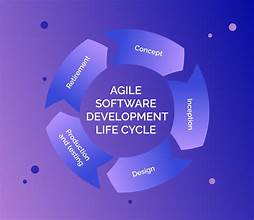Demystifying Agile Software Development: A Comprehensive Guide
software development
methadology
Posted by admin on 2024-05-04 14:18:28 |
Share: Facebook |
Twitter |
Whatsapp |
Linkedin Visits: 2370

In today's fast-paced software development landscape, traditional, rigid methodologies are struggling to keep up. Enter Agile – a flexible and collaborative approach that prioritizes adaptability and continuous improvement. This guide serves as your one-stop shop for everything Agile, from core principles to practical implementation.
What is Agile Software Development?
Agile software development is an umbrella term for a set of methodologies that emphasize iterative development, continuous feedback, and collaboration. Unlike traditional waterfall methods with pre-defined stages, Agile embraces change and prioritizes delivering working software in short cycles. This allows teams to adapt to evolving requirements and ensure the final product aligns with user needs.
The Core Values of Agile:
The Agile Manifesto, a foundational document, outlines four core values that guide Agile development:
- Individuals and interactions over processes and tools: Agile values the human element and fosters collaboration within teams.
- Working software over comprehensive documentation: The focus is on delivering functional software early and often, with documentation evolving alongside the project.
- Customer collaboration over contract negotiation: Agile encourages continuous customer involvement to ensure the final product meets their needs.
- Responding to change over following a plan: Agile embraces change as inevitable and allows teams to adapt to new requirements effectively.
Benefits of Agile Software Development:
The core values of Agile translate into a multitude of benefits for software development teams and businesses:
- Increased Flexibility: Agile allows teams to adapt to changing requirements and market demands with greater ease.
- Improved Quality: Continuous feedback loops lead to early detection and correction of defects, resulting in higher quality software.
- Enhanced Customer Satisfaction: Close collaboration with stakeholders ensures the final product aligns with their needs and expectations.
- Faster Time to Market: Delivering working software in short iterations allows for quicker product launches and faster ROI.
- Boosted Team Morale: Agile fosters a collaborative environment where team members feel empowered and valued.
Popular Agile Frameworks:
Agile is not a one-size-fits-all approach. Several frameworks provide specific structures for implementing Agile principles. Here's an overview of two popular options:
-
Scrum: Scrum is a highly popular framework that utilizes short development cycles called "sprints" (typically 1-4 weeks). Teams work collaboratively within each sprint to deliver a set of functionalities defined in a "product backlog." Daily stand-up meetings, sprint planning sessions, and sprint reviews ensure clear communication and progress tracking.
-
Kanban: Kanban utilizes a visual board system to manage work. Tasks are represented by cards that move through different stages, such as "To Do," "In Progress," and "Done." This allows for a clear visualization of workflow and facilitates continuous improvement. Kanban is less rigid than Scrum and offers greater flexibility for ongoing work.
Implementing Agile in Your Software Development Project (A Step-by-Step Guide):
Ready to embrace Agile in your next project? Here's a step-by-step guide:
- Assemble Your Agile Team: Form a cross-functional team with representatives from development, design, testing, and product management.
- Define Your Project Vision and Goals: Clearly outline what you want to achieve with the project and set measurable goals.
- Create a Product Backlog: List all features and functionalities your software should possess, prioritizing by importance and user needs.
- Break Down Work into User Stories: Break down functionalities from the backlog into user stories, which are detailed descriptions of features from the user's perspective.
- Estimate User Stories: As a team, estimate the effort required to complete each user story. Common estimation techniques include story points or time in hours.
- Plan and Conduct Sprints: Determine your sprint length (e.g., 2 weeks) and hold sprint planning sessions to define the set of user stories to be completed in each sprint.
- Daily Stand-up Meetings: Start each workday with a brief stand-up meeting to discuss progress, identify roadblocks, and plan for the day.
- Continuous Integration and Delivery (CI/CD): Automate building, testing, and deployment processes to streamline development and ensure frequent software updates.
- Gather Feedback and Iterate: At the end of each sprint, conduct sprint reviews with stakeholders to gather feedback and adapt the product backlog for the next sprint.
- Celebrate Successes and Retrospectives: Regularly acknowledge team achievements and hold retrospective sessions to analyze what worked well and identify areas for improvement.
Real-World Examples of Agile in Action:
- Netflix: This video streaming powerhouse utilizes a customized Agile framework to continuously improve its platform. They prioritize A/B testing and data-driven decision making to personalize user experiences and deliver the content their audience craves.
- Dropbox: Dropbox, the popular file storage service, adopted Kanban to streamline its workflow and improve development efficiency. This allows them to focus on continuously enhancing existing features while remaining adaptable to user needs and market trends.
- The New York Times: The renowned newspaper embraced Agile to improve its digital content production process. They utilize Scrum sprints to deliver new features and functionalities to their website and mobile app, ensuring a dynamic and engaging user experience.
- BMW: Even in traditional industries like automotive manufacturing, Agile is making waves. BMW utilizes Scrum to manage software development for their in-car entertainment systems. This allows them to adapt to new technologies and user demands quickly, keeping their vehicles at the forefront of innovation.
The Takeaway: Embrace Agility for Success in the Software Development Landscape
The Agile approach to software development offers a multitude of benefits for businesses and teams. Its emphasis on flexibility, collaboration, and continuous improvement allows for faster time to market, increased product quality, and ultimately, happier customers. Whether you're a startup or an established company, there's an Agile framework that can be tailored to your specific needs. By embracing Agile principles and implementing them effectively, you can empower your team to deliver exceptional software products that stay ahead of the curve.
